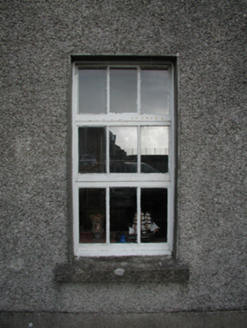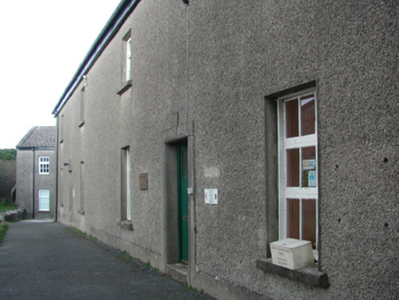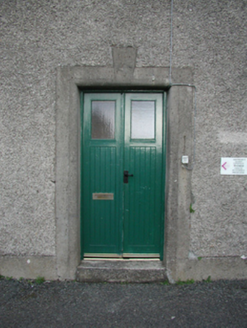Survey Data
Reg No
15618005
Rating
Regional
Categories of Special Interest
Architectural, Historical, Social
Original Use
Barracks
In Use As
Office
Date
1770 - 1840
Coordinates
272739, 108189
Date Recorded
21/10/2008
Date Updated
--/--/--
Description
Detached six-bay two-storey soldier accommodation block or soldier barrack, extant 1840, on a symmetrical plan originally attached. Occupied, 1901. Vacant, 1911. Burnt, 1922. In ruins, 1933. Reconstructed, 1939. Vacated, 1986. Now in alternative use. Hipped slate roof with lichen-spotted concrete ridge tiles, rendered chimney stacks centred on rendered chimney stack having stepped capping supporting terracotta pots, and replacement uPVC rainwater goods on eaves boards on roughcast eaves. Roughcast walls on rendered plinth with rendered quoins to ends. Pair of square-headed door openings with cut-granite step thresholds, and rendered "bas-relief" surrounds centred on keystones framing glazed timber boarded double doors. Square-headed window openings with concrete sills, and concealed red brick block-and-start surrounds framing timber casement windows. Set in shared grounds including relandscaped parade ground.
Appraisal
A soldier accommodation block or soldier barrack contributing positively to the group and setting values of the Duncannon Fort complex with the architectural value of the composition suggested by such attributes as the symmetrical footprint; and the diminishing in scale of the openings on each floor producing a graduated visual impression: meanwhile, aspects of the composition clearly illustrate the near-total reconstruction of the soldier accommodation block or soldier barrack at the outbreak of "The Emergency" (1939-46). Having been well maintained, the form and massing survive intact together with quantities of the original fabric, both to the exterior and to the restrained interior, thus upholding the character or integrity of a soldier accommodation block or soldier barrack forming part of a self-contained ensemble making a dramatic visual statement overlooking Waterford Harbour.





